Unveiling the Potential of Novel Macrophytes for the Treatment of Tannery Effluent in Vertical Flow Pilot Constructed Wetlands
Abstract
1. Introduction
2. Materials and Methods
2.1. Design Configuration of CWs
2.2. Collection and Characterization of Tannery Effluent
2.3. Operation and Maintenance of CWs
2.4. Analysis of Effluent Quality
2.5. Macrophytes Growth and Biomass Yield
2.6. Data Analysis
3. Results
3.1. Characterization of Tannery Effluent
3.2. Treatment Performance of Macrophytes
3.3. Growth and Biomass Yield of Macrophytes
4. Discussion
5. Conclusions
Author Contributions
Funding
Acknowledgments
Conflicts of Interest
References
- Verma, T.; Tiwari, S.; Tripathi, M.; Ramteke, P.W. Treatment and recycling of wastewater from tannery. In Advances in Biological Treatment of Industrial Wastewater and Their Recycling for a Sustainable Future; Singh, R.L., Singhj, R.P., Eds.; Springer: Singapore, 2019; pp. 51–90. [Google Scholar]
- Vymazal, J. Removal of nutrients in various types of constructed wetlands. Sci. Total Environ. 2007, 380, 48–65. [Google Scholar] [CrossRef] [PubMed]
- Shelef, O.; Gross, A.; Rachmilevitch, S. Role of plants in a constructed wetland: Current and new perspectives. Water 2013, 5, 405–419. [Google Scholar] [CrossRef]
- Ramirez, S.; Torrealba, G.; Lameda-Cuicas, E.; Molina-Quintero, L.; Stefanakis, A.I.; Pire-Sierra, M.C. Investigation of pilot-Scale Constructed Wetlands treating simulated pre-Treated tannery wastewater under tropical climate. Chemosphere 2019, 234, 496–504. [Google Scholar] [CrossRef] [PubMed]
- Garfi, M.; Flores, L.; Ferrer, I. Life cycle assessment of wastewater treatment systems for small communities: Activated sludge, constructed wetlands and high rate algal ponds. J. Clean. Prod. 2017, 161, 211–219. [Google Scholar] [CrossRef]
- Ashraf, S.; Afzal, M.; Rehman, K.; Naveed, M.; Zahir, Z.A. Plant-Endophyte synergism in constructed wetlands enhances the remediation of tannery effluent. Water Sci. Technol. 2018, 77, 1262–1270. [Google Scholar] [CrossRef]
- Saraswat, S.; Rai, D.J. Aquatic macrophytes mediated remediation of toxic metals from moderately contaminated industrial effluent. Int. J. Phytorem. 2018, 20, 876–884. [Google Scholar] [CrossRef]
- Calheiros, C.S.; Castro, P.M.; Gavina, A.; Pereira, R. Toxicity abatement of wastewaters from tourism units by constructed wetlands. Water 2019, 11, 2623. [Google Scholar] [CrossRef]
- Avellan, T.; Gremillion, P. Constructed wetlands for resource recovery in developing countries. Renew. Sust. Energy Rev. 2019, 99, 42–57. [Google Scholar] [CrossRef]
- Brix, H. Do macrophytes play a role in constructed treatment wetlands? Water Sci. Tech. 1997, 35, 11–17. [Google Scholar] [CrossRef]
- Chong, Y.X.; Hu, H.Y.; Qian, Y. Advances in utilization of macrophytes in water pollution control. Tech. Equip. Environ. Pollut. Control 2003, 2, 36–40. [Google Scholar]
- Brisson, J.; Chazarenc, F. Maximizing pollutant removal in constructed wetlands: Should we pay more attention to macrophyte species selection? Sci. Total Environ. 2009, 407, 3923–3930. [Google Scholar] [CrossRef]
- Calheiros, C.S.C.; Rangel, A.O.; Castro, P.M. Treatment of industrial wastewater with two-Stage constructed wetlands planted with Typha latifolia and Phragmites australis. Bioresour. Technol. 2009, 100, 3205–3213. [Google Scholar] [CrossRef]
- Thomaz, S.M.; Cunha, E.R.D. The role of macrophytes in habitat structuring in aquatic ecosystems: Methods of measurement, causes and consequences on animal assemblages′ composition and biodiversity. Acta Limnol. Bras. 2010, 22, 218–236. [Google Scholar] [CrossRef]
- Gagnon, V.; Chazarenc, F.; Comeau, Y.; Brisson, J. Influence of macrophyte species on microbial density and activity in constructed wetlands. Water Sci. Technol. 2007, 56, 249–254. [Google Scholar] [CrossRef] [PubMed]
- Calheiros, C.S.C.; Duque, A.F.; Moura, A.; Henriques, I.S.; Correia, A.; Rangel, A.O.; Castro, P.M. Changes in the bacterial community structure in two-Stage constructed wetlands with different plants for industrial wastewater treatment. Bioresour. Technol. 2009, 100, 3228–3235. [Google Scholar] [CrossRef] [PubMed]
- Calheiros, C.S.C.; Duque, A.F.; Moura, A.; Henriques, I.S.; Correia, A.; Rangel, A.O.; Castro, P.M. Substrate effect on bacterial communities from constructed wetlands planted with Typha latifolia treating industrial wastewater. Ecol. Eng. 2009, 35, 744–753. [Google Scholar] [CrossRef]
- Klomjek, P.; Nitisoravut, S. Constructed treatment wetland: A study of eight plant species under saline conditions. Chemosphere 2005, 58, 585–593. [Google Scholar] [CrossRef]
- Tanner, C.C. Plants for constructed wetland treatment systems—A comparison of the growth and nutrient uptake of eight emergent species. Ecol. Eng. 1996, 7, 59–83. [Google Scholar] [CrossRef]
- Kouki, S.; Saidi, N.; Rajeb, A.B.; M’hiri, F. Potential of a polyculture of Arundo donax and Typha latifolia for growth and phytotreatment of wastewater pollution. Afr. J. Biotechnol. 2012, 11, 15341–15352. [Google Scholar]
- Licata, M.; Gennaro, M.C.; Tuttolomondo, T.; Leto, C.; La Bella, S. Research focusing on plant performance in constructed wetlands and agronomic application of treated wastewater–A set of experimental studies in Sicily (Italy). PLoS ONE 2019, 14. [Google Scholar] [CrossRef]
- Aalam, T.; Khalil, N. Performance of horizontal sub-surface flow constructed wetlands with different flow patterns using dual media for low-Strength municipal wastewater: A case of pilot scale experiment in a tropical climate region. J. Environ. Sci. Heal. Part A 2019, 54, 1245–1253. [Google Scholar] [CrossRef] [PubMed]
- Rugaika, A.M.; Kajunguri, D.; Van Deun, R.; Van der Bruggen, B.; Njau. K.N. Mass transfer approach and the designing of horizontal subsurface flow constructed wetland systems treating waste stabilisation pond effluent. Water Sci. Technol. 2019, 78, 2639–2646. [Google Scholar] [CrossRef] [PubMed]
- Li, J.; Wen, Y.; Zhou, Q.; Xingjie, Z.; Li, X.; Yang, S.; Lin, T. Influence of vegetation and substrate on the removal and transformation of dissolved organic matter in horizontal subsurface-flow constructed wetlands. Bioresour. Technol. 2008, 99, 4990–4996. [Google Scholar] [CrossRef] [PubMed]
- Gao, F.; Yang, Z.H.; Li, C.; Jin, W.H. Saline domestic sewage treatment in constructed wetlands: Study of plant selection and treatment characteristics. Desalin. Water Treat. 2015, 53, 593–602. [Google Scholar] [CrossRef]
- Mant, C.; Costa, S.; Williams, J.; Tambourgi, E. Phytoremediation of chromium by model constructed wetland. Bioresour. Technol. 2006, 97, 1767–1772. [Google Scholar] [CrossRef] [PubMed]
- Gruber, H.; Wiessner, A.; Kuschk, P.; Kaestner, M.; Appenroth, K.J. Physiological responses of Juncus effusus (rush) to chromium and relevance for wastewater treatment in constructed wetlands. Int. J. Phytorem. 2008, 10, 79–90. [Google Scholar] [CrossRef] [PubMed]
- Aguilar, J.R.P.; Cabriales, J.J.P.; Vega, M.M. Identification and characterization of sulfur-Oxidizing bacteria in an artificial wetland that treats wastewater from a tannery. Int. J. Phytorem. 2008, 10, 359–370. [Google Scholar] [CrossRef]
- Sundaramoorthy, P.; Chidambaram, A.; Ganesh, K.S.; Unnikannan, P.; Baskaran, L. Chromium stress in paddy: (i) Nutrient status of paddy under chromium stress; (ii) Phytoremediation of chromium by aquatic and terrestrial weeds. Comptes Rendus Biol. 2010, 333, 597–607. [Google Scholar] [CrossRef]
- Yadav, S.; Chandra, R. Heavy metals accumulation and ecophysiological effect on Typha angustifolia L. and Cyperus esculentus L. growing in distillery and tannery effluent polluted natural wetland site, Unnao, India. Environ. Earth Sci. 2011, 62, 1235–1243. [Google Scholar] [CrossRef]
- Liu, J.; Zhang, X.H.; You, S.H.; Wu, Q.X.; Chen, S.M.; Zhou, K.N. Cr (VI) removal and detoxification in constructed wetlands planted with Leersia hexandra Swartz. Ecol. Eng. 2014, 71, 36–40. [Google Scholar] [CrossRef]
- Terfie, T.A.; Asfaw, S.L. Evaluation of selected wetland plants for removal of chromium from tannery wastewater in constructed wetlands, Ethiopia. Afr. J. Environ. Sci. Technol. 2015, 9, 420–427. [Google Scholar]
- Ashraf, S.; Afzal, M.; Rehman, K.; Tahseen, R.; Naveed, M.; Zahir, Z.A. Enhanced remediation of tannery effluent in constructed wetlands augmented with endophytic bacteria. Desalin. Water Treat. 2018, 102, 93–100. [Google Scholar] [CrossRef]
- Kaseva, M.; Mbuligwe, S. Potential of constructed wetland systems for treating tannery industrial wastewater. Water Sci. Technol. 2010, 61, 1043–1052. [Google Scholar] [CrossRef] [PubMed][Green Version]
- Ranieri, E.; Young, T.M. Clogging influence on metals migration and removal in sub-Surface flow constructed wetlands. J. Contam. Hydrol. 2012, 129, 38–45. [Google Scholar] [CrossRef] [PubMed]
- Saeed, T.; Afrin, R.; Al Muyeed, A.; Sun, G. Treatment of tannery wastewater in a pilot-Scale hybrid constructed wetland system in Bangladesh. Chemosphere 2012, 88, 1065–1073. [Google Scholar] [CrossRef] [PubMed]
- Baskar, G.; Deeptha, V.T.; Annadurai, R. Comparison of treatment performance between constructed wetlands with different plants. Int. J. Res. Eng. Technol. 2014, 3, 210–214. [Google Scholar]
- Sultana, M.Y.; Mourti, C.; Tatoulis, T.; Akratos, C.S.; Tekerlekopoulou, A.G.; Vayenas, D.V. Effect of hydraulic retention time, temperature, and organic load on a horizontal subsurface flow constructed wetland treating cheese whey wastewater. J. Chem. Technol. Biotechnol. 2015, 91, 726–732. [Google Scholar] [CrossRef]
- Calheiros, C.S.C.; Rangel, A.O.; Castro, P.M. Constructed wetland systems vegetated with different plants applied to the treatment of tannery wastewater. Water Res. 2007, 41, 1790–1798. [Google Scholar] [CrossRef]
- Calheiros, C.S.C.; Quiterio, P.V.; Silva, G.; Crispim, L.F.; Brix, H.; Moura, S.C.; Castro, P.M. Use of constructed wetland systems with Arundo and Sarcocornia for polishing high salinity tannery wastewater. J. Environ. Manage. 2012, 95, 66–71. [Google Scholar] [CrossRef]
- Sehar, S.; Naeem, S.; Perveen, I.; Ali, N.; Ahmed, S. A comparative study of macrophytes influence on wastewater treatment through subsurface flow hybrid constructed wetland. Ecol. Eng. 2015, 81, 62–69. [Google Scholar] [CrossRef]
- APHA. Standard Methods for the Examination of Water and Wastewater, 20th ed.; American Public Health Association: Washington, DC, USA, 2005. [Google Scholar]
- Shehzadi, M.; Afzal, M.; Khan, M.U.; Islam, E.; Mobin, A.; Anwar, S.; Khan, Q.M. Enhanced degradation of textile effluent in constructed wetland system using Typha domingensis and textile effluent-Degrading endophytic bacteria. Water Res. 2014, 58, 152–159. [Google Scholar] [CrossRef] [PubMed]
- Ashraf, S.; Afzal, M.; Naveed, M.; Shahid, M.; Zahir, Z.A. Endophytic bacteria enhance remediation of tannery effluent in constructed wetlands vegetated with Leptochloa fusca. Int. J. Phytoremediat. 2018, 20, 121–128. [Google Scholar] [CrossRef] [PubMed]
- Bell, G.P. Ecology and Management of Arundo Donax, and Approaches to Riparian Habitat Restoration in Southern California; Plant Invasions: Studies from North America and Europe; Wade, J.H., Pysek, P., Green, D., Eds.; Leiden: Blackhuys, The Netherlands, 1997; pp. 103–113. [Google Scholar]
- Greenway, M.; Woolley, A. Changes in plant biomass and nutrient removal over 3 years in a constructed free water surface flow wetland in Cairns Australia. In Proceedings of the 7th International conference on Wetland Systems for Water Pollution Control, Lake Buena Vista, FL, USA, 11–16 November 2000; pp. 707–718. [Google Scholar]
- Barco, A.; Borin, M. Treatment performance and macrophytes growth in a restored hybrid constructed wetland for municipal wastewater treatment. Ecol. Eng. 2017, 107, 160–171. [Google Scholar] [CrossRef]
- Farzi, A.; Borghei, S.M.; Vossoughi, M. The use of halophytic plants for salt phytoremediation in constructed wetlands. Int. J. Phytoremediat. 2017, 19, 643–650. [Google Scholar] [CrossRef] [PubMed]
- Shelef, O.; Gross, A.; Rachmilevitch, S. The use of Bassia indica for salt phytoremediation in constructed wetlands. Water Res. 2012, 46, 3967–3976. [Google Scholar] [CrossRef] [PubMed]
- Fountoulakis, M.S.; Daskalakis, G.; Papadaki, A.; Kalogerakis, N.; Manios, T. Use of halophytes in pilot-Scale horizontal flow constructed wetland treating domestic wastewater. Environ. Sci. Pollut. Res. 2017, 24, 16682–16689. [Google Scholar] [CrossRef]
- Sood, A.; Uniyal, P.L.; Prasanna, R.; Ahluwalia, A.S. Phytoremediation potential of aquatic macrophyte. Azolla. Ambio. 2012, 41, 122–137. [Google Scholar] [CrossRef]
- Yang, Z.; Wang, Q.; Zhang, J.; Xie, H.; Feng, S. Effect of plant harvesting on the performance of constructed wetlands during summer. Water 2016, 8, 24. [Google Scholar] [CrossRef]
- Rozema, E.R.; Gordon, R.J.; Zheng, Y. Harvesting plants in constructed wetlands to increase biomass production and Na+ and Cl− removal from recycled greenhouse nutrient solution. Water Air Soil Pollut. 2016, 227, 1–8. [Google Scholar] [CrossRef]
- Girdhar, M.; Sharma, N.R.; Rehman, H.; Kumar, A.; Mohan, A. Comparative assessment for hyperaccumulatory and phytoremediation capability of three wild weeds. 3 Biotech 2014, 4, 579–589. [Google Scholar] [CrossRef]
- Song, U.; Park, H. Importance of biomass management acts and policies after phytoremediation. J. Ecol. Environ. 2017, 41, 13. [Google Scholar] [CrossRef]
- Pat-Espadas, A.M.; Portales, R.L.; Amabilis-Sosa, L.E.; Gomez, G.; Vidal, G. Review of constructed wetlands for acid mine drainage treatment. Water 2018, 10, 1685. [Google Scholar] [CrossRef]
- Vymazal, J. Horizontal sub-Surface flow and hybrid constructed wetlands systems for wastewater treatment. Ecol. Eng. 2005, 25, 478–490. [Google Scholar] [CrossRef]
- Mahmood, Q.; Pervez, A.; Zeb, B.S.; Zaffar, H.; Yaqoob, H.; Waseem, M.; Afsheen, S. Natural treatment systems as sustainable ecotechnologies for the developing countries. BioMed. Res. Int. 2013, 2013. [Google Scholar] [CrossRef] [PubMed]
- Jahan, M.A.A.; Akhtar, N.; Khan, N.M.S.; Roy, C.K.; Islam, R.; Nurunnabi, M. Characterization of tannery wastewater and its treatment by aquatic macrophytes and algae. Bangladesh J. Sci. Ind. Res. 2015, 4, 233–242. [Google Scholar] [CrossRef]
- Shahid, M.J.; Ali, S.; Shabir, G.; Siddique, M.; Rizwan, M.; Seleiman, M.F.; Afzal, M. Comparing the performance of four macrophytes in bacterial assisted floating treatment wetlands for the removal of trace metals (Fe, Mn, Ni, Pb, and Cr) from polluted river water. Chemosphere 2020, 243, 125353. [Google Scholar] [CrossRef] [PubMed]
- Jamshidi, S.; Akbarzadeh, A.; Woo, K.S.; Valipour, A. Wastewater treatment using integrated anaerobic baffled reactor and Bio-rack wetland planted with Phragmites sp. and Typha sp. J. Environ. Health Sci. Eng. 2014, 12, 131. [Google Scholar] [CrossRef]
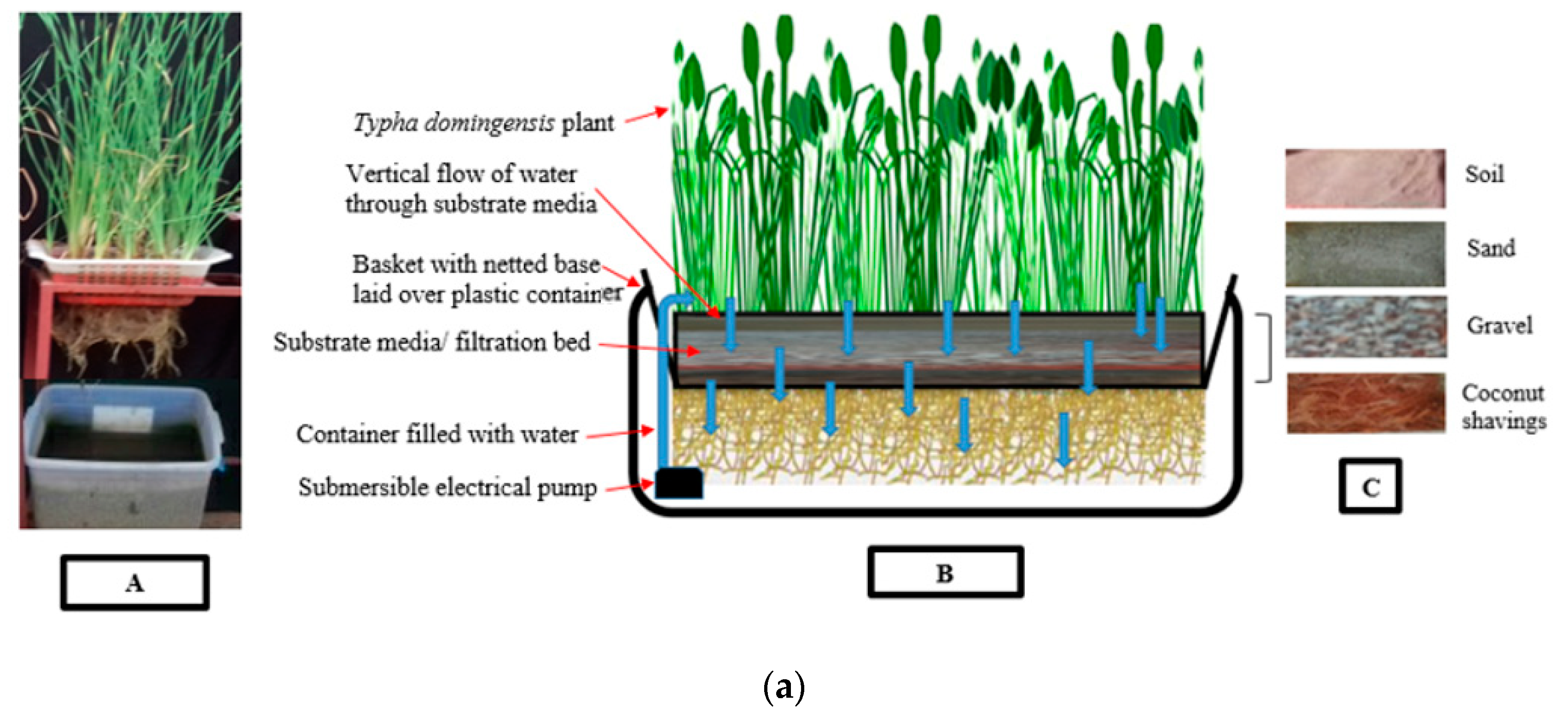
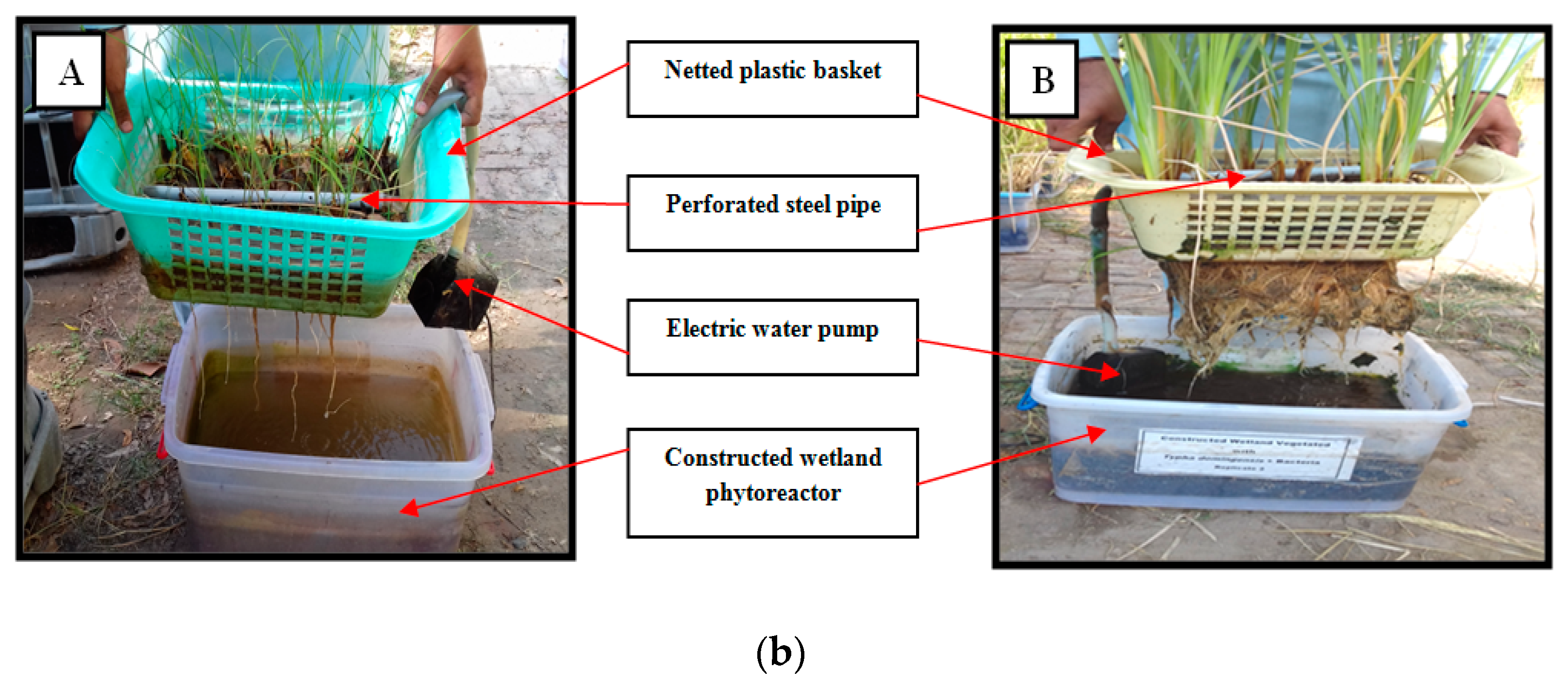
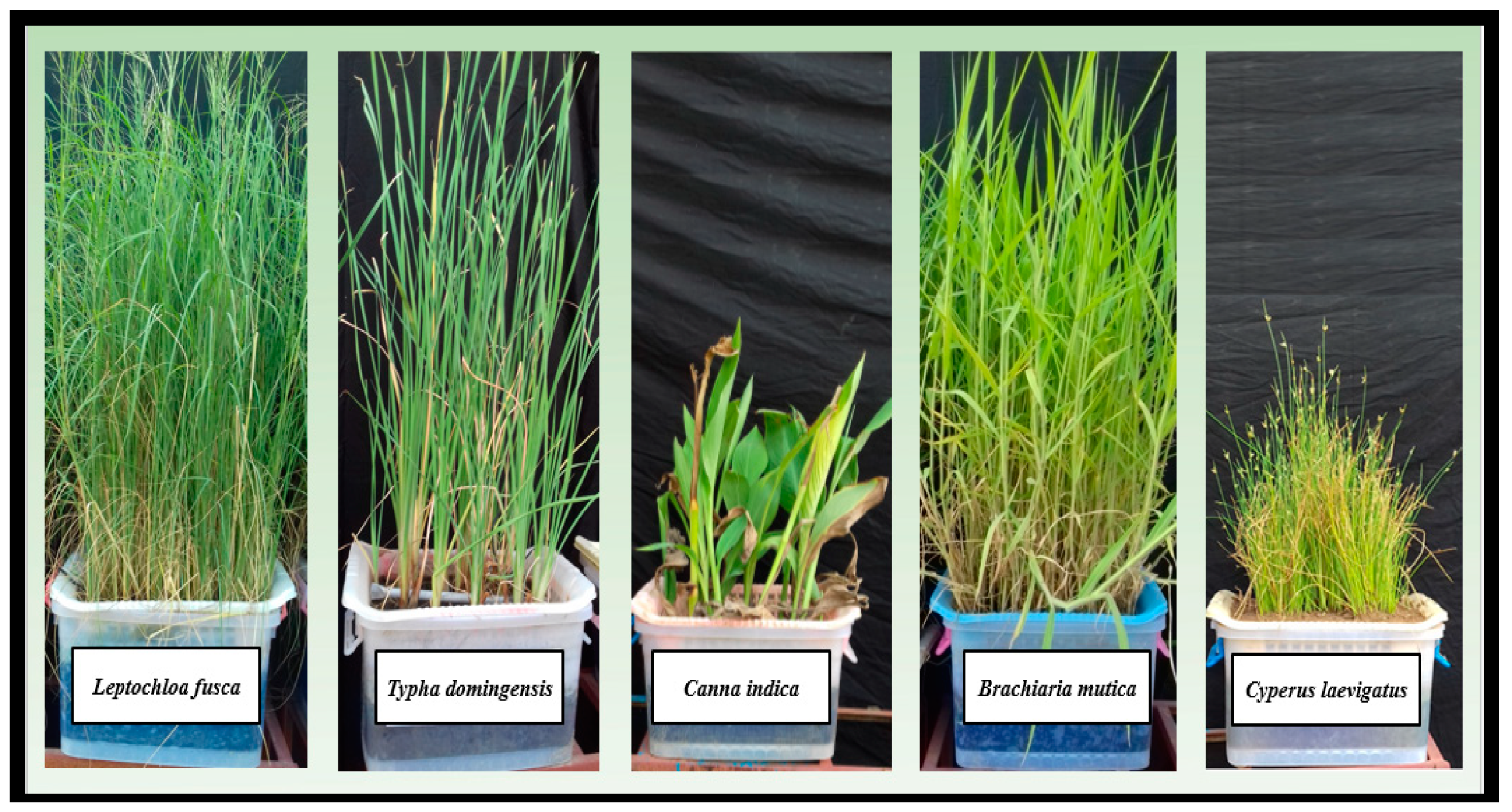
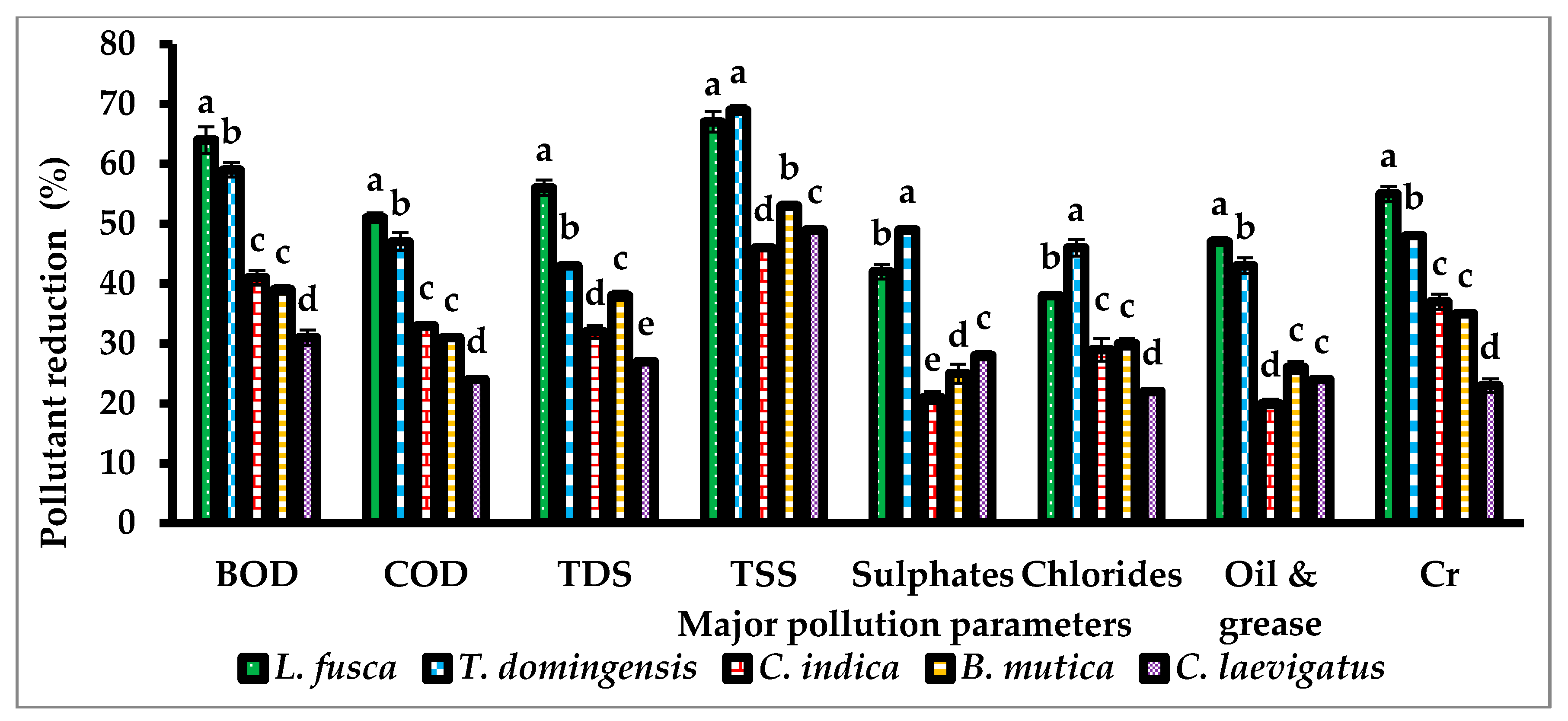
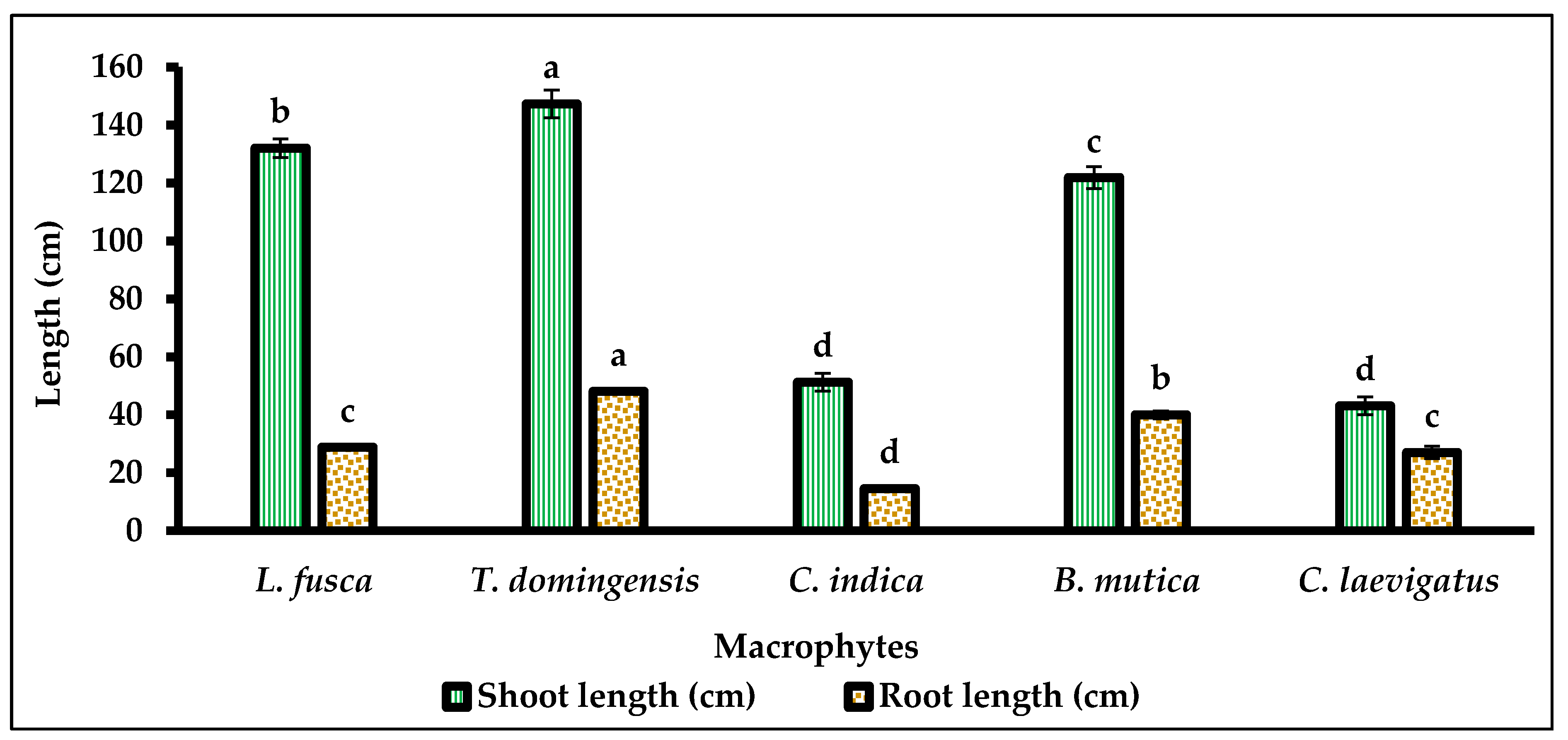
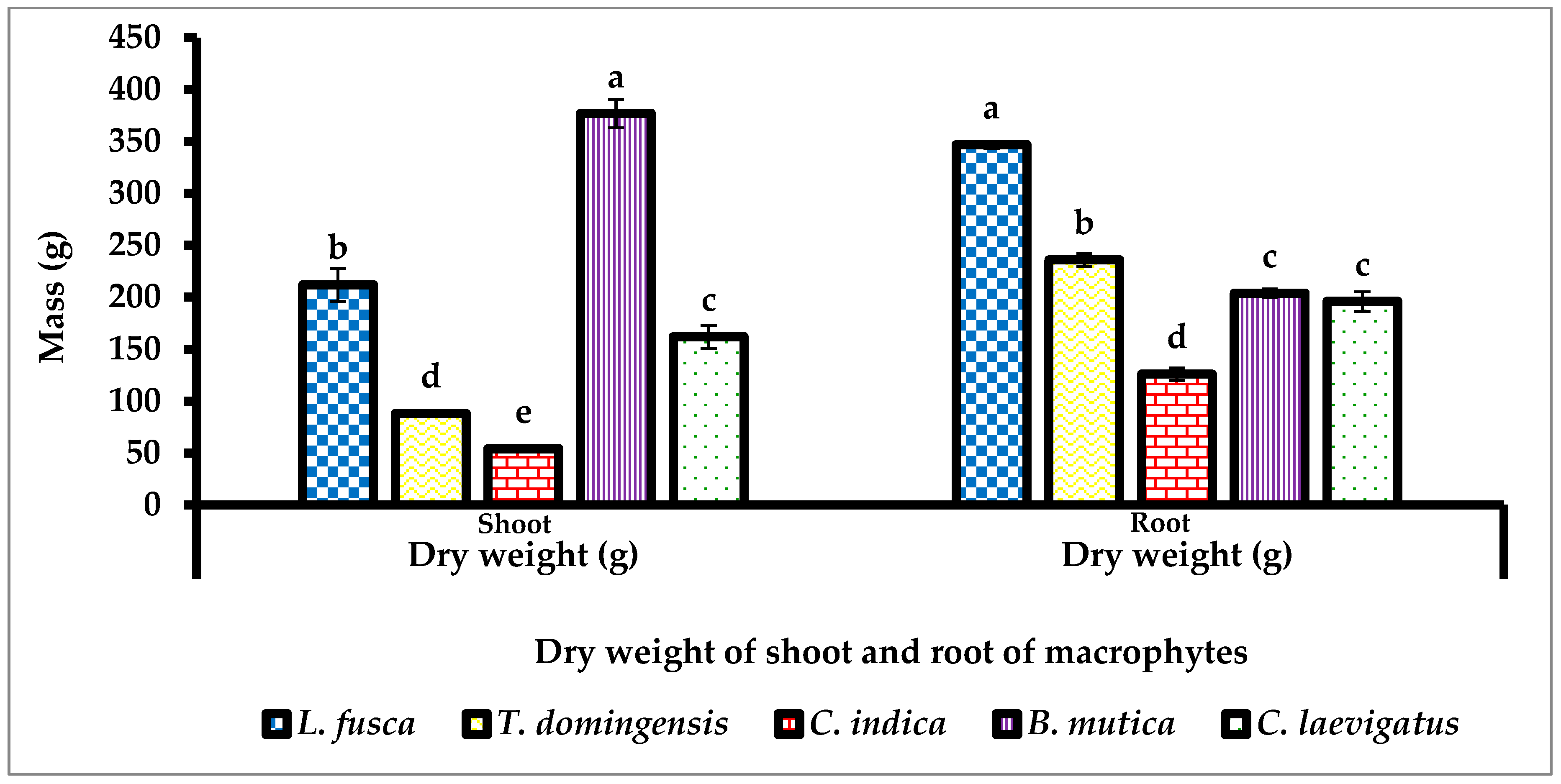
| Parameters | Values (Mean ± SD) | NEQS | Parameters | Values (Mean ± SD) | NEQS |
|---|---|---|---|---|---|
| Color appearance | Black | Grey | TS (mg/L) | 13,710 ± 608 | NG |
| Color intensity (m−1) | 61.2 ± 1.2 | NG | TSS (mg/L) | 2854 ± 230 | 150 |
| Odor | Foul smell | NG | TSeS (mg/L) | 8 ± 0.1 | NG |
| Temperature (°C) | 31 ± 0.3 | 40 | SO42− (mg/L) | 1789 ± 113 | NG |
| pH | 8.0 ± 0.4 | 6–10 | Cl− (mg/L) | 3315 ± 249 | 1000 |
| EC (mS/cm) | 16.5 ± 1.4 | NG | Total Cr (mg/L) | 134 ± 5.8 | 1.0 |
| TDS (mg/L) | 10,560 ± 978 | 3500 | Cr6+ (mg/L) | 0.48 ± 0.15 | 0.25 |
| COD (mg/L) | 5634 ± 245 | 150 | Cr3+ (mg/L) | 133 ± 1.4 | 0.75 |
| BOD5 (mg/L) | 2910 ± 341 | 80 | Oil and grease (mg/L) | 145 ± 5.6 | 10 |
| Pollution Parameters (mg/L) | Before Treatment Mean ± SD | Characteristics of Tannery Effluent after Treatment by CWs Planted with Different Plant Species Mean ± SD | NEQS | ||||
|---|---|---|---|---|---|---|---|
| L. fusca | T. domingensis | C. indica | B. mutica | C. laevigatus | |||
| BOD5 | 2910 ± 341 | 1047 ± 131 | 1193 ± 56 | 1717 ± 165 | 1775 ± 48 | 2008 ± 129 | 80 |
| COD | 5634 ± 245 | 2760 ± 201 | 2986 ± 237 | 3775 ± 179 | 3887 ± 160 | 4281 ± 242 | 150 |
| TDS | 10,560 ± 978 | 5913 ± 563 | 6019 ± 732 | 7180 ± 945 | 6547 ± 504 | 7708 ± 660 | 3500 |
| TSS | 2854 ± 230 | 942 ± 76 | 884 ± 146 | 1541 ± 98 | 1341 ± 43 | 1455 ± 94 | 150 |
| Sulphates | 1789 ± 113 | 1038 ± 104 | 912 ± 74 | 1413 ± 140 | 1342 ± 49 | 1288 ± 125 | NG |
| Chlorides | 3315 ± 249 | 2055 ± 130 | 1790 ± 167 | 2354 ± 248 | 2320 ± 173 | 2586 ± 204 | 1000 |
| Oil and grease | 145 ± 5.6 | 77 ± 2.3 | 82 ± 12 | 116 ± 5.1 | 107 ± 6.6 | 110 ± 9.3 | 10 |
| Cr | 134 ± 5.8 | 60 ± 2.4 | 69 ± 10.7 | 84 ± 4 | 87 ± 3.1 | 103 ± 8.5 | 1 |
© 2020 by the authors. Licensee MDPI, Basel, Switzerland. This article is an open access article distributed under the terms and conditions of the Creative Commons Attribution (CC BY) license (http://creativecommons.org/licenses/by/4.0/).
Share and Cite
Ashraf, S.; Naveed, M.; Afzal, M.; Seleiman, M.F.; Al-Suhaibani, N.A.; Zahir, Z.A.; Mustafa, A.; Refay, Y.; Alhammad, B.A.; Ashraf, S.; et al. Unveiling the Potential of Novel Macrophytes for the Treatment of Tannery Effluent in Vertical Flow Pilot Constructed Wetlands. Water 2020, 12, 549. https://doi.org/10.3390/w12020549
Ashraf S, Naveed M, Afzal M, Seleiman MF, Al-Suhaibani NA, Zahir ZA, Mustafa A, Refay Y, Alhammad BA, Ashraf S, et al. Unveiling the Potential of Novel Macrophytes for the Treatment of Tannery Effluent in Vertical Flow Pilot Constructed Wetlands. Water. 2020; 12(2):549. https://doi.org/10.3390/w12020549
Chicago/Turabian StyleAshraf, Sobia, Muhammad Naveed, Muhammad Afzal, Mahmoud F. Seleiman, Nasser A. Al-Suhaibani, Zahir A. Zahir, Adnan Mustafa, Yahya Refay, Bushra Ahmed Alhammad, Sana Ashraf, and et al. 2020. "Unveiling the Potential of Novel Macrophytes for the Treatment of Tannery Effluent in Vertical Flow Pilot Constructed Wetlands" Water 12, no. 2: 549. https://doi.org/10.3390/w12020549
APA StyleAshraf, S., Naveed, M., Afzal, M., Seleiman, M. F., Al-Suhaibani, N. A., Zahir, Z. A., Mustafa, A., Refay, Y., Alhammad, B. A., Ashraf, S., Alotaibi, M., & Abdella, K. A. (2020). Unveiling the Potential of Novel Macrophytes for the Treatment of Tannery Effluent in Vertical Flow Pilot Constructed Wetlands. Water, 12(2), 549. https://doi.org/10.3390/w12020549










